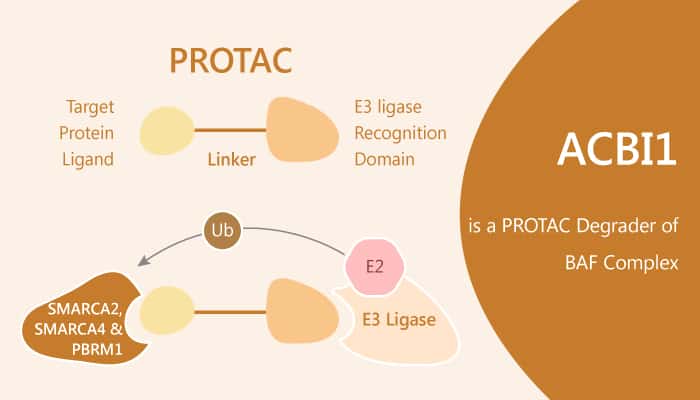Proteolysis targeting chimeras (PROTACs) are getting more and more attention. In previous blogs, I have introduced many protein degraders based in PROTAC technology, including MT-802, dBET6, MZP-55, MZP-55, ERD-308, MS4077, BSJ-03-123, A1874 and TD-428. Today, I’d like to mention a novel PROTAC degrader of BAF complex, ACBI1.

The ATP-dependent activities of the BAF (SWI/SNF) chromatin remodeling complexes affect the positioning of nucleosomes on DNA. Therefore, they effect various cellular processes related to chromatin structure, including transcription, DNA repair and decatenation of chromosomes during mitosis. According to report, the BAF complex mutation approximately accounts for 20% in human cancers, and usually contains one of two mutually exclusive ATPases, SMARCA2 or SMARCA4. While SMARCA4 acts as a tumor suppressor in solid tumors. SMARCA4 is required to maintain the oncogenic transcription program and drive proliferation especially in acute myeloid leukemia (AML). As such, inhibition of SMARCA2 activity selectively may become a therapeutic concept for SMARCA4-mutated cancers.
A study from William Farnaby discovered and identified the novel BAF complex degrader ACBI1. ACBI1 is a potent PROTAC degrader of BAF ATPase subunits SMARCA2 and SMARCA4, also degrades the polybromo-associated BAF (PBAF) complex member PBRM1. It exhibits DC50 values of 6 nM, 11 nM and 32 nM for SMARCA2, SMARCA4 and PBRM1 in MV-4-11 cells, respectively. In addition, ACBI1 is composed of a bromodomain ligand, a linker, and the E3 ubiquitin ligase VHL.
Furthermore, in cancer cells, ACBI1 induced anti-proliferative effects and cell death caused by SMARCA2 depletion in SMARCA4 mutant cancer cells, and in acute myeloid leukemia cells dependent on SMARCA4 ATPase activity.